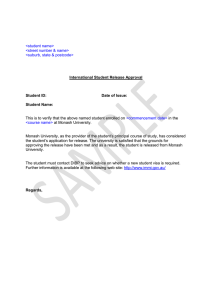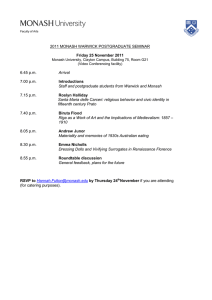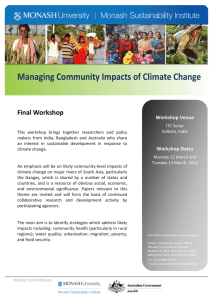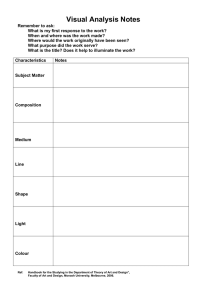Power at Half a Million Volts - Administration, Monash University
advertisement
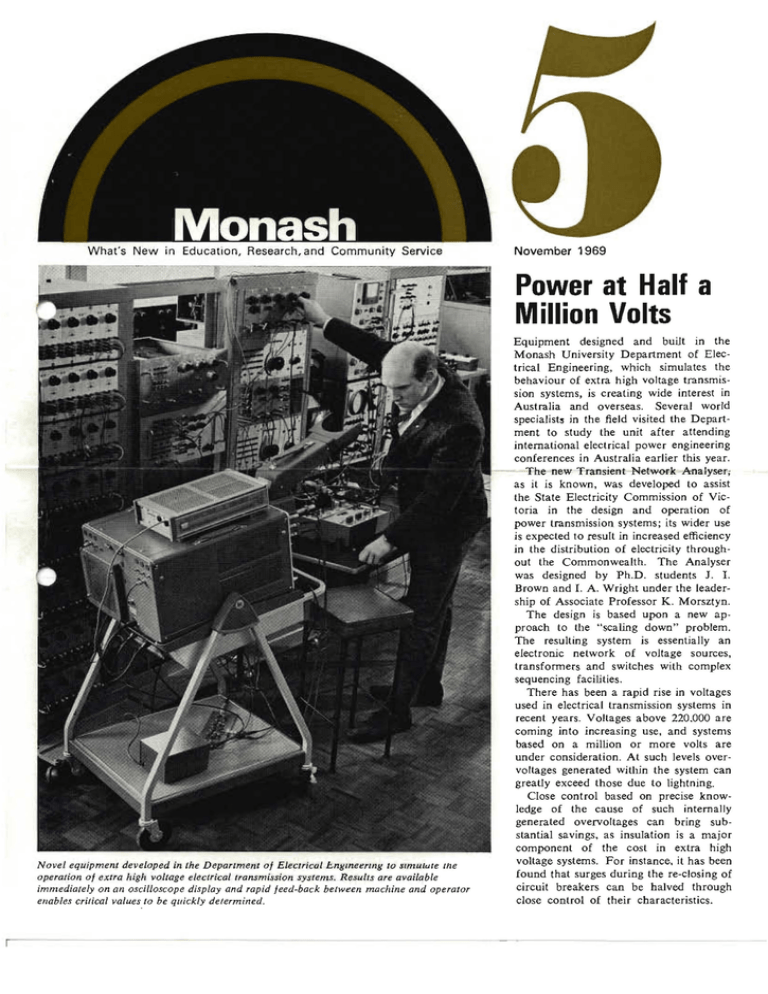
Whafs New in Education, Research, and Community Service
November 1969
Power at Half a
Million Volts
Novel equipm ent developed in the Department of Electrical Engtneenng to stmutute tne
operation of extra high voltage electrical transmission systems. Results are available
imm ediately on an oscilloscope display and rapid feed-ba ck between machine and operator
enables critical values to be quickly de/ermined.
Equipment designed and built in the
Monash University Department of Elec­
trical Engineering, which simulates the
behaviour of extra high voltage transmis­
sion systems, is creating wide interest in
Australia and overseas. Several world
speciall sts in the field visited the Depart­
ment to study the unit after attending
international electrical power engineering
conferences in Australia earlier this year.
The new Transient Network Analyser;
as it is known, was developed to assist
the State Electricity Commission of Vic­
toria in the design and operation of
power transmiss ion systems; its wider use
is expected to result in increased efficiency
in the distribution of electricity through­
out the Commonwealth. Th e Analyser
was designed by Ph .D. students J. 1.
Brown and 1. A. Wright under the leader­
ship of Associate Professor K. Morsztyn.
The design is based upon a new ap ­
proach to the "scaling down " problem .
The resulting system is essentially an
electronic netwo rk of voltage sources,
tran sformers and switches with complex
sequencing facilities.
There has been a rapid rise in voltages
used in electrical transmission systems in
recent years. Voltages above 220.000 are
coming into increasing use, and systems
based on a million or more volts are
under consideration. At such levels over­
voltages generated within the system can
greatly exceed tho se due to lightning.
Close control based on prec ise know­
ledge of the cause of such internally
generated overvoltages can bring sub­
stantial savings, as insulation is a major
component of the cost in extra high
voltage systems . For instance. it has been
found that surges during the re-closing of
circuit breakers can be halved through
close control of their characteristics.
Hefriqerator
Nears Absolute
Zero
A revolutionary low-temperature refrig­
erator that can operate continuously at a
temperature of one-twent ieth of a degree
above ab solute zero (-459°F.) has been
con structed in the Monash Department
of Physics.
The unit IS based on a method de­
veloped by the British Atomic Energy
Commission about 3 years ago. Although
the principle resembles that employed in
conventional fuel (kerosene or gas) re­
frigerators, the materials are vastly dif ­
ferent . Operation at temperatures near
absolute zero is achieved by using a non­
radioactive isotope of helium (3He) as
the main refrigerant in a dilution cycle .
Demagnetization cryostats in use in the
Department will achi eve even lower tem­
peratures, but cannot cope with heat in­
puts as high as the dilution refrigerator.
The most recent cryo stat con structed at
Monash has already operated at O.Ol °K
(zero On the Kel vin scale is absolute
zero - the temperature at which matter
has minimum energy) and is expected to
reach O.003°K - equal to the lowest tem ­
perature yet achieved by similar cryostats
elsewhere.
These low-temperature research facili­
ties are unique in Australia and only
the Univ ersitie s of Oxford, Moscow, and
Californ ia have comparable equipment.
They are being used by Professor R .
Street and Dr. G. V. H. Wilson to study
the behaviour of magnetic materials in
extremely high magnetic fields.
Dramatic changes in the magnetic
behaviour of metals take place near abso­
lute zero . Radioactive nuclei of certain
atoms incorporated in ferromagnetic
metals can be aligned magnetically at
these temperatures. The gamma radia­
tion emitted by the atomic nuclei then
becomes stronger in some directions than
in others; accordingly, this behaviour
provides important information about
magnetic fields acting within atoms.
The Monash research programme has
been strongly supported by the Austra­
lian Research Grants Committee. There
is increasing interest in low-temperature
phenomena throughout the world and
participation at the frontiers of this new
field of technology by an Australian
group should provide a training ground
and a base for any industrial applications
that may develop. Eight graduate students
are currently working full time on various
aspects of the project.
Below right; Mr . M . F . Wood, who
designed the British prototype, helped with
the construction of the M onash dilution
refri gerator . He is examining one of the
series of jacket s which are filled with pro­
gressively colder liquids to minimize loss of
heat from the unit . Vital technicaL construe­
tion was done by Mr. Jack Sullivan who is
seen below with th e new ma gnetization
cryostat.
International
Trade
Recent developments in economic think­
ing about the protection of national in­
dustries were among the topics discussed
at a conference on international trade
convened by the Monash University
Department of Economics in September.
Leading British and American authorities
exchanged views with specialists on inter­
national trade from 12 Australian unive r­
sities at the 3-day symposium.
Conferences of this nature are rare in
Au stralia, and, as the proceedings should
be of considerable interest to economists
in other countries, they are ' to be pub­
lished as a book.
Two visiting economists in the Monash
Faculty - Professor Harry G . John
of the London School of Economics aud
Political Science and the University of
Chicago, and Dr. W. M. Corden from
Nuffield College, Oxford - presented
papers on protection and the European
Common Market
Subjects discussed by members of the
Monash Department of Economics in­
cluded interactions between commodities
that do and do not enter into int ernational
trade (Professor 1. A. McDougall), for­
ward exchange and commodity futures
(Dr. R. H. Snape), and a programming
model that can be used to measure the
effects upon trade of various types and
levels of protection (Dr. H . David
Evans) .
Students Help
Aboriginal Miners
"We think that a large scheme like th is
could break the mental barriers that
Aborigines seem to have; they ar e always
getting the leftovers, the smalJ schemes,
the piecemeal schemes , the guilt-complex
schemes, the gifts of handkerchiefs, when
what they want is something really large
- som e land - some thing of sign ificant
size that they can see and own and hold
and keep ."
This is the conc lusion of a team of
Monash graduate students who lived for
a month with a unique group of desert
Aborigines in the harsh Pilbara region of
Western Australia. These semi -nomadic
survivors of an original tribe of the
ion now live by mining, Their drive
<lu G competence so impressed the students
that the latter dr ew up an ambitious,
long-term scheme intended to ensure the
economic and social survival of the group
in its ancestral lands .
The project was initiated by "Abschol",
the nat ional stud ent body formed origi­
nally to assist Aboriginal students at Aus­
tralian univer sities. However, the stu­
dents soon found that very few Abo­
riginal children were being educated to
secondary school level, let alone to that
of university entrance, So Abschol
broadened its objectives beyond educa­
tion to include other types of problems
faced by Aboriginal communities.
The Monash team that shared the life
of the Pilbara mmmg Aborigines for a
period in mid -I969 comprised Rosalind
Turnbull, a graduate in anthropology,
and Ian Wallis, a civil engineer interested
in the interaction between Man's activi­
ties and th e natural environment that he
exploits,
The Aboriginal group consist s of about
150 adults and children, most of whom
are full- blood s of the Nyangumata tribe .
Th e most active of the five tribal sub­
groups comprises some 25 adults and
their children, mining alluvial tin , tanta­
lite, and columbite 100 miles south of
Port H eadland, and another 65 mining
allu vial tin about 25 miles fur ther south.
The tr ibal remnants are led by Don
McLeod , a white man who has been with
the tribe since 1946. He has served the
group as geologi st, mechanic, and busi­
ness manager for many years, but is now
approaching the age of retirement.
The students were impressed by the
resilience of the Aborigines and by their
tenacity and toughness in wandering all
over the north of Western Australia,
moving from creek to creek and from
mineral to mineral in response to the
realities of mining economics.
These Aborigines have retain ed their
identity as an ethnic group while adapt­
ing successfully to western civilization.
They speak both the Nyangurnata lan­
guage and English, but few are literate
an d their kn owledge .of the ' white world
is gained mainly through transistor
radios, They know about space travel
and pointed out satellites to the Monash
stud ents, yet they have an official rain­
. .
~J
11\'\ :'""
.,
V"T ' , "
~
. IA
.
,
...
.
Fram es from a 16 mm movie film made by
tire Abschol team during its sojourn with
the Aboriginal min ers ill (he Pilbara region
of We stern Australia•
.~
~
,
~
~~{:\',\,,~
'
'"'" ""',,..,
.
- "'I'
)/.
maker and follow many other native
customs.
Inevitably the mining activ ities of the
group have clashed with the realities of
current large-scale mineral exploration,
with the result that the economic basis
of its survival as a tribal un it has been
undermined.
Tile Abschol team found that the
Aborigines were th inking about the
future and planning for their continuous
existence as a viable social unit. They
told the students of a plan to use the
profits from a substantial mineral enter­
prise they are attempting to develop to
buy a pastoral property, which they
would manage and work as a group, This
10-year plan would provide a permanent
asset upon which future generations of
the tribal group could build.
The scheme, as submitted to Abschol
by the team from Mon ash, visua lizes
development of 400 square miles at the
headwaters of the Yule River to support
an Aboriginal settlement centred on the
rais ing of cattle. But the Aborigines
realize that appropriate technical and
managerial skills will have to be acquired.
Education is thus an essential element
in the proposal.
They recommend that a professional
group should be sent to the Pilbara
region in 1970 to study the feasibility of
the min ing scheme and of the longer-term
'I
•
,., !¥'
?1[ ....,
, '~
IN'
' .. ~r ·~
. .~
'.
",- ' J r
•
,
. . -.....• i<
• . ,J
.. .
·':;f,o
. , .. ..., .
,..,.~
..
~~.
.....
;:
J'"
'#1 . ' :0'
.:
·
1 .:.,.,
t.'~"',.",...:'
. .~'. :. :. ;, ~
'\" "~
J;&
~ .
.>,!~
~...~';..,. ; .'l' "::',.;{'1,,__
,
, ',J~
•
\\
~
".
•
•
" 'i!""" ~'~
~ " ~
~
­
.
11
"
.
,
~1
\';"
,."
t:.
'I~
6
' '''' ~
"
.
I
,
1~1
~
i
,
\
~
'\'I
\
,
~
.
.~~.
I
' ~~~
~~~~~ ;
t . .
).
~ .\ .....
\'J'
....... . _
J
"
~if; ~
, _.
,
~·tfl-·
I
l' ~k r. "'~~~
.MJ
,"'I~.. ..jWl',
;J/~.,'
~ 'r~>
,
·
~
'.
•
. ,
". -
...
• -
•
. .
I
~
~
pastoral proposition. A geologist, a
m ining engineer, and agricultural scien­
tists will form the nucleus of the working
party. Economists will report on potential
profitability of the enterprises and lawyers
may be needed to unravel some complex
legal aspects of the mining leases.
The cost of the feasibility study, in­
cluding some hole-sinking on the mineral
deposit, pumping tests of underground
water, crop trials, and so on, ar e esti­
mated at about $60,000. A guidance com­
mittee comprising both Abschol and out­
side interests will be established to
organize the ra ising of the necessary
funds in universities in all States.
Joeys from an
"Extinct Wallaby
U
The first ever birth in captivity of a
parma or white-throated wallaby took
place in Monash University's Jock Mar­
shall Wildlife Reserve on March 10, 1968.
This small relative of the kangaroo was
believed to have become extinct in 1932.
Its resurrection in 1966 excited natural­
ists and provided zoologists with an un­
expected second chance to study its
physiology and behaviour and to com­
pare its characteristics with those of
other marsupials.
Graduate stud ents in the University's
Department of Zoology led by Dr. E.
H. M. Ealey, have already discovered
some important facts about the response
of the parma wallaby to temperature
changes and about its reproduction . Such
Pltl NTED BY BROWN
PR10R
ANDE:RSON
J'OR MONAS H UN]~ lTY, MIi:LBOURNE
r­
information may ultimately explain why
the species was never numerous, why it
did not spread beyond relatively small
areas near the coast of New South Wales,
and why it has now become virtually
an extinct species.
Nothing was seen or heard of the
parma wallaby between 1932 and 1966,
when a colony was discovered on Kawau
Island, off the coast of New Zealand.
The animals were apparently the progeny
of several introduced from Australia
about 1880. A few months later a female
wallaby killed on a road near Gosford,
N .S.W., was identified as Macropus
parma - the parma wallaby. Although
no further sightings have occurred, scien ­
tists believe that it is probably not ex­
tinct in Australia, but may survive as a
rare species in part of its original, rather
inaccessible rainforest environment.
In 1967, the Sporting Shooters Associa­
tion of Australia financed the purchase
and shipment to Melbourne of 31 of the
wallabies from Kawau Island . Some of
these were housed at the Melbourne Zoo,
some at the Healesville Wildlife Sanc ­
tuary, and some at Monash University,
where zoologists immediately began an
intensive investigation of their physiology
and behaviour.
Reproduction of the parma is being
studied by Gerald Maynes and its heat­
regulating mechanisms by Robert Wallis.
Although the parma share s certain fea­
tures of its reproductive mechanism with
the majority of its marsupial relatives,
some characteristics are unusual. For in­
stance, an individual animal may on one
occasion breed again immediately after
giving birth to the immature, tiny pouch
embryo, and on another occasion may
not do so. Thus it vacillates between
the behaviour of the majority of kan­
garoos and wallabies in which fertiliza­
tion is effected soon after birth and the
egg remains inactive until required, and
that of a minority typified by the grey
kang aroo, which does not breed again
at this extremely early stage. It was
found that parmas have a comparatively
long oestrous (breeding) cycle (42 days)
and duration of pregnancy (134 days) .
The young leave the pouch permanently
about 215 days after birth, but are not
weaned for a further 9 to 12 weeks.
Some marsupials are less capable of
maintaining a constant body temperature
than animals higher on the evolutiona ry
scale, such as Man and farm animals.
However, experiments at Monash showed
that the parma can regulate its body t·
perature qu ite effectively at atmospher.c
temperatures between about 50°C. and
30°C. The species can apparently cope
with cold better than it can with heat.
The ma in mechanism by which the
parma gets rid of excessive heat at high
temperatures is evaporative cooling,
mainly from the tongue by panting.
Th e Melbourne colonies are prospering
and knowledge of their reproductive sys­
tem is now sufficient to ensure their sur­
vival, at least in captivity.
Below: Studying (he parma wallaby in the
Univ ersity's Jock Mar shall Wildlife
R eserve . The ex/ rem ely small, newly-bam
embryo (top right) will remain atta ched
to a teat in (he pouch until mature.
